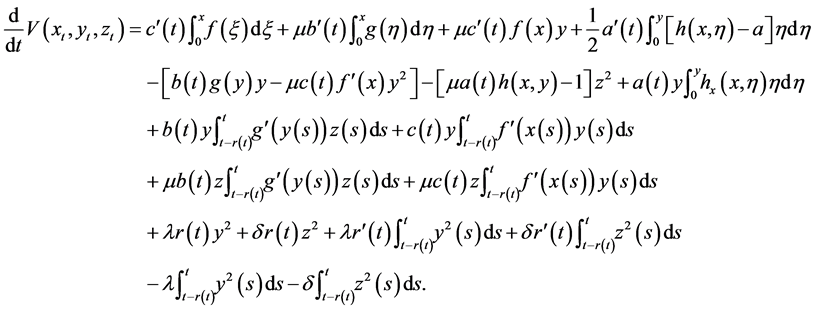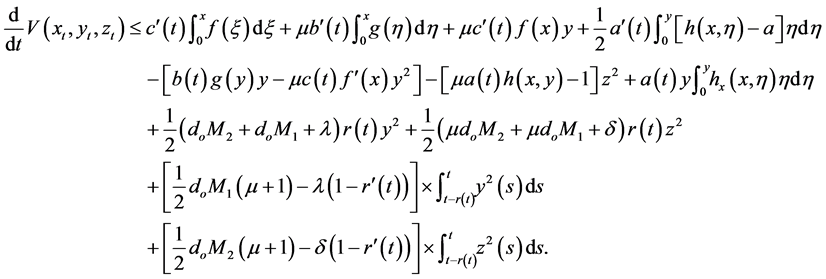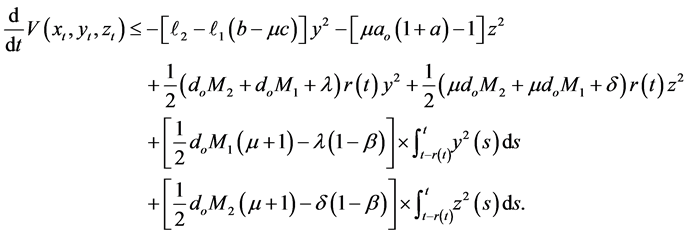Applied Mathematics
Vol.07 No.06(2016), Article ID:64925,11 pages
10.4236/am.2016.76041
On the Stability and Boundedness of Solutions of Certain Non-Autonomous Delay Differential Equation of Third Order
Akinwale L. Olutimo1*, Daniel O. Adams2
1Department of Mathematics, Lagos State University, Ojo, Nigeria
2Department of Mathematics, Federal University of Agriculture, Abeokuta, Nigeria

Copyright © 2016 by authors and Scientific Research Publishing Inc.
This work is licensed under the Creative Commons Attribution International License (CC BY).
http://creativecommons.org/licenses/by/4.0/



Received 23 January 2016; accepted 21 March 2016; published 24 March 2016
ABSTRACT
In this paper, we study certain non-autonomous third order delay differential equations with continuous deviating argument and established sufficient conditions for the stability and boundedness of solutions of the equations. The conditions stated complement previously known results. Example is also given to illustrate the correctness and significance of the result obtained.
Keywords:
Asymptotic Stability, Boundedness, Lyapunov Functional, Delay Differential Equations, Third-Order Delay Differential Equations

1. Introduction
This paper considers the third order non-autonomous nonlinear delay differential
 (1.1)
(1.1)
or its equivalent system
 (1.2)
(1.2)
where ,
,  ,
,  , β and
, β and  are some positive constants,
are some positive constants,  will be determined later,
will be determined later,  ,
,  ,
,  are real valued functions continuous in their respective arguments on
are real valued functions continuous in their respective arguments on ,
,  ,
,  ,
,  ,
,  ,
, 














In applied science, some practical problems are associated with Equation (1.1) such as after effect, nonlinear oscillations, biological systems and equations with deviating arguments (see [1] - [3] ). It is well known that the stability of solutions plays a key role in characterizing the behavior of nonlinear delay differential equations. Stability is much more complicated for delay equations. Thus, it is worthwhile to continue to investigate the stability and boundedness of solutions of Equation (1.1) and its various forms.
Equation of the form (1.1) in which


and established conditions for the stability and boundedness of solution when 

and obtains the conditions for its boundedness of solution.
Results obtained are now extended to non-autonomous delay differential Equation (1.1). Results obtained in this work are comparable in generality to the results of Sadek [7] on analogous third order differential equation which itself generalizes an analogous third-order results of Zhu [5] , and also complement existing results on third order delay differential equations. We establish sufficient conditions for the stability (when

Now, we will state the stability criteria for the general non-autonomous delay differential system. We consider:

where 
and for

Definition 1.0.1 ( [8] ) An element 










Definition 1.0.2 ( [8] [13] ) A set 





Lemma 1 ([8,13]) An element 






Lemma 2 ( [8] [13] ) Let 

1) 


2) 
Then the zero solution of (1.3) is uniformly stable. If we define

The following will be our main stability result (when
2. Statement of Results
Theorem 1 In addition to the basic assumptions imposed on the functions a(t), b(t), c(t), 

1)



2)


3)


4)



Then, the zero solution of system (1.2) is asymptotically stable, provided that

and

Proof
Our main tool is the following Lyapunov functional 

where 

We also assume that
where
By the assumption 


The Lyapunov functional (2.4) can be arranged in the form
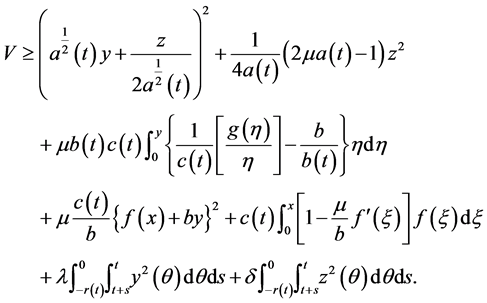
From Theorem 1, 


Thus, there is a 

By (2) and (3) of Theorem 1, we have that the third term on the right in (2.5)

and next two terms give

Using (2.6), (2.7) and (2.8) in (2.5), we have

where
and integrals
Thus, for some positive constants 



For the time derivative of the Lyapunov functional (2.3), along a trajectory of the system (1.2), we have
From (4) of Theorem 1, 


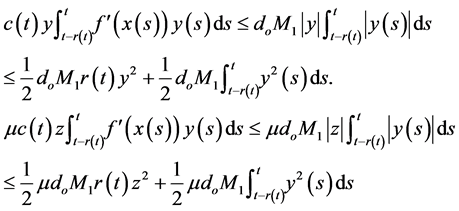
Similarly, we obtain

Thus,
If



where by (3) of Theorem 1,
And by (1) and (2) of Theorem 1,
as

According to (2) of Theorem 1, 



and by (3) and (4) of Theorem 1, we have that
for all 

Thus, from (2.11), (2.12), (2.13), (2.14) and (2.15), we have
If we choose
and
and using
Choosing
we have

for some
Finally, it follows that 




Thus, (2.10) and (2.16) and the last statement agreed with Lemma 2. This shows that the trivial solution of (1.1) is asymptotically stable.
Hence, the proof of the Theorem 1 is now complete.
Remark 2.1 If 






Remark 2.2 If 

3. The Boundedness of Solution
Theorem 2 We assume that all the assumptions of Theorem 1 and
hold, where 
Then, there exists a finite positive constant K such that the solution 
satisfies the inequalities
for all

Proof of Theorem 2
As in Theorem 1, the proof of Theorem 2 depends on the scalar differentiable Lyapunov function 
Since
In view of (2.16),
Since 

Hence, it follows that
for a constant

Making use of the inequalities 

By (2.10), we have
Hence,
or
where
Multiplying each side of this inequality by the integrating factor
Integrating each side of this inequality from 0 to t, we get, where
or
Since 

Now, since the right-hand side is a constant, and since 


From the Equation (1.1) this implies
The proof of Theorem 2 is now complete.
Remark 3.1 If 



4. Conclusions
The solutions of the third-order non-autonomous delay system are asymptotically stable and bounded according to the Lyapunov’s theory if the inequalities (2.1) and (2.2) are satisfied.
Example 3.1 We consider non-autonomous third-order delay differential equation
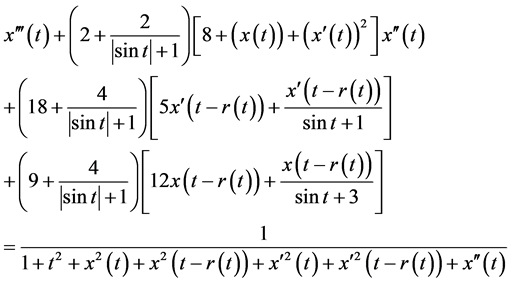
with equivalent system of (3.1) as:
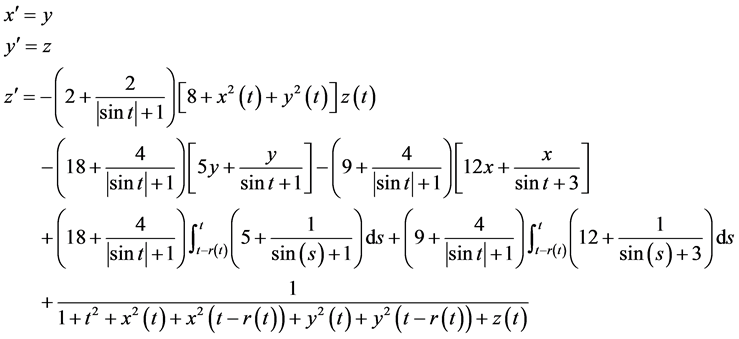
comparing (1.2) with (3.2), it is easy to see that
The function
The function
also,
Since
we have
It follows that
tually by a period-doubling cascade leading to chaos.
Finally,
and
Thus, all assumptions of Theorem 1 and Theorem 2 are held. That is, zero solution of Equation (1.1) is asymptotically stable and all the solutions of the same equation are bounded.
Cite this paper
Akinwale L.Olutimo,Daniel O.Adams, (2016) On the Stability and Boundedness of Solutions of Certain Non-Autonomous Delay Differential Equation of Third Order. Applied Mathematics,07,457-467. doi: 10.4236/am.2016.76041
References
- 1. Afuwape, A.U., Omari, P. and Zanalin, F. (1989) Nonlinear Pertubations of Differential Operators with Nontrivial Kernel and Applications to Third-Order Periodic Boundary Problems. Journal of Mathematical Analysis and Applications, 143, 35-36.
http://dx.doi.org/10.1016/0022-247X(89)90027-9 - 2. Cronin, J. (1997) Some Mathematics of Biological Oscillations. SIAM Review, 19, 100-137.
http://dx.doi.org/10.1137/1019007 - 3. Rauch, L.L. (1950) Oscillations of a Third-Order Nonlinear Autonomous System in Contributions to the Theory of Nonlinear Oscillations. Annals of Mathematics Studies, 20, 39-88.
- 4. Sadek, A.I. (2003) On the Stability and Boundedness of a Kind of Third Order Delay Differential System. Applied Mathematics Letters, 16, 657-662.
http://dx.doi.org/10.1016/S0893-9659(03)00063-6 - 5. Sadek, A.I. (2005) On the Stability of Solutions of Some Non-Autonomous Delay Differntial Equations of Third Order. Asymptotic Analysis, 43, 1-7.
- 6. Zhu, Y.F. (1992) On Stability, Boundedness and Existence of Periodic Solution of a Kind of Third Order Nonlinear Delay Differential System. Annals of Differential Equations, 8, 249-259.
- 7. Afuwape, A.U. and Omeike, M.O. (2008) On the Stability and Boundedness of Solutions of a Kind of Third Order Delay Differential Equations. Applied Mathematics and Computation, 200, 444-451.
http://dx.doi.org/10.1016/j.amc.2007.11.037 - 8. Ademola, A.T. and Aramowo, A.T. (2013) Uniform Stability and Boundedness of Solutions of Non-Linear Delay Differential Equations of Third Order. Mathematical Journal of Okayama University, 55, 157-166.
- 9. Yao, H. and Meng, W. (2008) On the Stability of Solutions of Certain Non-Linear Third Order Delay Differential Equations. International Journal of Non-Linear Science, 6, 230-237.
- 10. Ademola, A.T., Ogundare, B.S., Ogundiran, M.O. and Adesina, O.A. (2015) Stability, Boundedness and Existence of Periodic Solutions to Certain Third-Order Delay Diffrential Equation with Multiple Deviating Arguments. International Journal of Differential Equations, 2015, Article ID: 213935.
- 11. Omeike, M.O. (2009) Stability and Boundedness of Solutions of Some Non-Autonomous Delay Differential Equation of the Third Order. Analele Stiintifice Ale Universitattii “Alexandru Ioan Cuza” Din Iasi Matematica, 55, 49-58.
- 12. Tunc, C. (2009) Boundedness in Third Order Nonlinear Differential Equations with Bounded Delay. Boletin de Mathematicas, 16, 1-10.
- 13. Tunc, C. (2006) New Results about Stability and Boundedness of Solutions of Certain Non-Linear Third Order Delay Differential Equations. The Arabian Journal for Science and Engineering, 31, 185-196.
NOTES
*Corresponding author.












